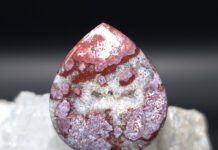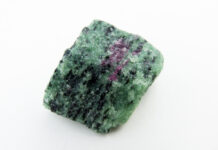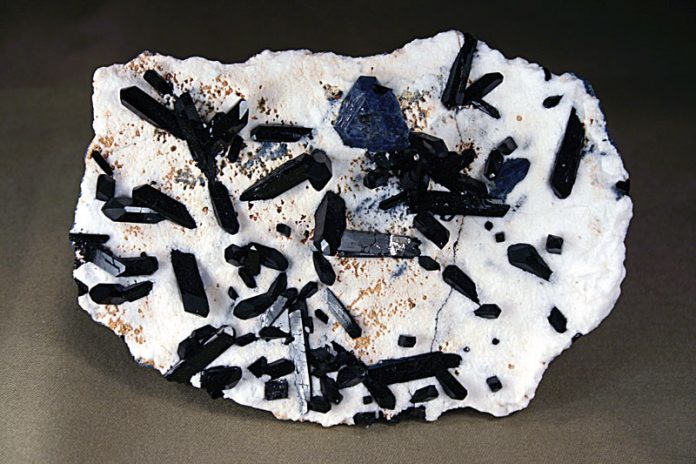
Named for the Roman Sea God, Neptunus, neptunite is often found with California State’s official gem mineral benitoite, such a bright blue gem that it tends to eclipse neptunite for attention. But neptunite is a beautiful mineral in its own right. It appears as a lustrous, black, opaque crystal on a stark white matrix.
Crystals can measure up to two inches with perfectly terminated prismatic faces in nice-sized display specimens. Neptunite is found in the San Benito Mountains, locked in a contrasting snow-white natrolite matrix. The specimens are very attractive and well worth collecting as the lustrous stark black crystals contrast nicely with blue benitoite and white natrolite matrix.
Neptunite is chemically complex composed of sodium, potassium, lithium, iron, manganese and titanium silicate. It is also found elsewhere as a high manganese neptunite and so-called mangan-neptunite. This forms when manganese substitutes for some of the iron atoms in neptunite’s chemistry.
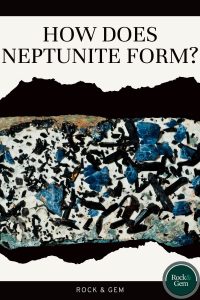
The neptunite from California is the iron end member of a series, with mangan-neptunite the opposite member. Localities that yield mangan-neptunite are nepheline syenite pegmatite deposits, unlike the San Benito source.
Asbestos Protection
Benitoite is a barium titanium silicate. It isn’t as chemically complex as neptunite. They form together in a hydrothermal replacement deposit made up of glaucophane schist and serpentine and the typical rock types in the San Benito Mountains. The entire range is composed mainly of metamorphic-type rocks that can also contain chrysotile asbestos. The composition of these mountains has been an important factor in recent years as we became more aware of the danger of fibrous minerals like asbestos.
The benitoite-neptunite deposit, usually called the Dallas Gem mine is subjected to health controls now. What used to be a place where rockhounds could enjoy a weekend of digging and claim owners could use heavy equipment was suddenly subjected to serious controls. No more heavy equipment is allowed. No blasting is possible and gem mining is really restricted to hand tools. The deposit today is still claimed and some collecting is possible. There is a fee to dig outside Coalings, CA, where you can search through material from the mine.
Gold Rush Beginnings
This unique deposit of benitoite and neptunite is a case of an accidental discovery. A prospector looking for one valuable mineral accidentally discovered another. Unlike most prospectors in California over 100 years ago, this prospector was not looking for gold but mercury. But even his search had its beginnings with the discovery of California gold in 1848.
When native gold is found in streams and rivers, the initial finds are tiny nuggets and flakes large enough to see so they can be separated from the sands and gravels with ease. But for centuries, prospectors have known they were missing the tiniest, nearly invisible flakes of gold, so when possible, they employed liquid mercury to capture the unseen gold or as known in prehistoric times, the oily fleece of a sheep, hence the “golden fleece” legend.
Mercury has an infinity for gold, combining with it to form an amalgam that is later easily parted with heat to recover both metals by boiling off the mercury to release the gold. The mercury is not lost as most of it can be captured for use again and again. The problem with using mercury is the initial cost, and some would be lost and had to be replaced. The early sources of mercury were mines located across the ocean in Spain and down in Mexico. As mercury demand grew with the California gold rush, so too did the need for and price of the liquid metal in 1849.
Finding Benitoite
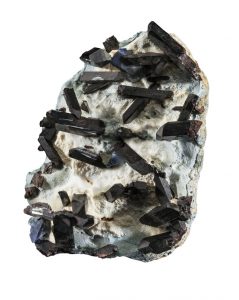
Fortunately, this problem was solved. The price of mercury dropped with the discovery of mercury deposits not far from the California gold fields at places named New Idria and New Almaden after Spanish mercury areas. With the increasing demand for mercury, prospectors began searching for it.
One lucky prospector, James Couch from nearby Coalinga, CA, set out to find mercury ore. Couch obtained a grubstake from R. R. Dallas and headed off in search of the liquid metal. After a couple of days in the field, Couch ended up camping in a high mountain meadow near the San Benito Mountains. In the morning, Couch noticed a large white area on the side of a nearby mountain and decided to check it out. To his delight, he found small bright blue gemstones that had weathered out of the white rock. Depending on what you read, Couch thought he had found diamonds or sapphire crystals.
Couch forgot about mercury prospecting and headed back to Coalinga to show his find to his benefactor R. Dallas. The stones were eventually tested at a university and proved to be a new mineral later named benitoite. I’ve read a lot about Couch’s discovery, including his own writings, and what is curious is that I find no mention of the lovely black neptunite crystals that had to be present in the white natrolite of Couch’s find. Indeed, that snow-white rock that attracted Couch had to have loose crystals of this black complex mineral scattered about right there with the blue benitoite.
Other Locations for Neptunite
The San Benito Mountains are not the only location neptunite has been found. Its type locality is a nepheline syenite pegmatite deposit at Narssarssuk, West Greenland. Crystals from here are sharp, up to an inch or so long, and shown to be the manganese-rich specimens called mangan-neptunite. Like so many minerals in a series, you can’t visually tell the difference between iron-rich neptunite and manganese-rich mangan-neptunite. Another essential source of manga-neptunite is Mount St. Hilaire, Canada, also a nepheline syenite deposit.
Joaquinite
Joaquinite is another mineral that’s even less well-known. It is found as tiny, nearly gemmy monoclinic crystals embedded throughout the white mineral. Joaquinite is very complex, even more so than neptunite. Chemically, it is comprised of sodium, barium, iron, titanium, silicon, oxygen and fluorine hydroxide.
Joaquinite crystals are seldom more than two or three millimeters across. One reason you seldom see joaquinite crystals is they are not firmly attached to any matrix. Like neptunite, they developed as free crystals simultaneously with white natrolite as they formed, just like neptunite and most benitoite.
Exposing Species
Since all three of these species, benitoite, neptunite and joaquinite, have free-formed and are completely enclosed in the developing natrolite, they can only be exposed and collected from the natrolite by etching the natrolite to expose the valuable crystals. The good thing is the crystals are almost all completely formed and doubly terminated in the case of neptunite. But, if etching the natrolite is not done with care, you end up with loose crystals. Since benitoite and neptunite had developed as large crystals, they are easily exposed with care. But the tiny joaquinite crystals, once loosened, might well be missed and lost.
Identifying Neptunite
Neptunite was finally identified in specimens from West Greenland in 1893. It is a monoclinic mineral that forms in elongate, square crystals. Terminations develop with sloping faces that come to a sharp straight edge. Most crystals have developed singly, but inter-grown clusters have often been found at the Dallas mine. They look black, but you may see their true color, a reddish cinnamon brown if examined on a thin edge. Crystals were well known long before the mineral was formally identified.
For decades the deposit was accessible to collectors. Some collectors made it a life’s work collecting at the Dallas Gem mine, often with great success. One pleasing property is that benitoite responds under short wave ultraviolet excitation as a brilliant blue color.
Color & Inclusions
The natural color of benitoite has been studied and is the result of what is called charge transfer, the action of electrons. As light energy enters the crystal, titanium and oxygen electrons get energized with light energy, and the electrons transfer back and forth between the titanium and oxygen. With electrons continually absorbing some light waves from the red end of the color spectrum, the complementary color of red, which is blue, becomes a dominant color and is visible.
Many benitoite crystals have gray-white zoning. This outcome is due to included white crossite fibers of the host rock, which get included in the benitoite as it develops. Neptunite does not seem to suffer inclusions, probably because neptunite crystals develop in the natrolite, away from the gray host rock.
While visiting mineral shows, the only neptunite crystal specimens you will see, and they are scarce, are from the benitoite-neptunite locality in the San Benito Mountains, California and they are definitely worth owning.
This story about neptunite previously appeared in Rock & Gem magazine. Click here to subscribe. Story by Bob Jones.



